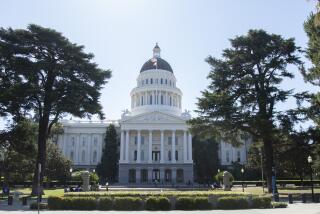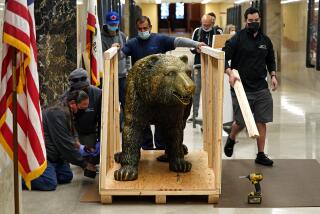Ruins Raise Rancor Between 2 Parties
- Share via
MADRID — While bulldozers rumble and city traffic crawls past, archeologist Esther Andreu steps into a pit and goes back centuries.
A few feet down a ramp, Andreu walks past remnants of a 16th century royal palace, the first ever built in Madrid. A yard deeper, she is back 600 more years, stopping at the base of a watchtower put up by Arab soldiers.
The pit, which is being dug in the Plaza de Oriente for a construction project, has revealed a millennium of Spain’s history, one marked by conquest and reconquest.
But because workers are removing or demolishing most of the ruins to make way for a parking garage and underpass, the discovery has also triggered a 20th century battle between Spain’s two biggest political parties.
The Socialist Party, which recently lost control of both the Madrid and national governments to the conservative Popular Party, accuses its successor of destroying historic relics to prevent the project from running over budget.
“An atrocity has been committed against our national patrimony,” raged Juan Antonio Ruiz, a Socialist in the Madrid Assembly.
Ruiz, and some archeologists, want the ruins incorporated into the project design.
But that would inflate the cost of the $32-million project by at least $5 million, says Gustavo Villapalos, a regional government official.
“That’s a lot of money,” Villapalos told Socialist deputies in a heated exchange in the Madrid Assembly in late September. “For you that doesn’t seem to matter, but to me it does, because it’s public money.”
The controversy is reinforcing the Popular Party’s image as party spoilers, the ones cutting aid to the arts and implementing other belt-tightening measures.
“Their action on the Plaza de Oriente project fits right in with the mercantile attitude of the Spanish right regarding culture and patrimony--money comes first,” Ruiz said.
But, like the Socialists’ sniping at the Popular Party for its austerity measures, which were imposed after overspending during Socialist rule, the center-leftists may share responsibility for what has happened.
The construction project began before the Popular Party won elections for the Madrid government in 1995, and much of the palace’s remnants had already been demolished, Villapalos says.
Ruiz denies that, saying that only exploratory digging had commenced when the Socialists handed over power.
What is being fought over are cellars and foundations of Madrid’s first royal palace and parts of an Arab fortress.
The Arabs built the fortress in the 10th century on a strategic bluff during their 700-year occupation of Spain. Two centuries after Spanish forces pushed them from the peninsula in 1492, the fortress burned down. Parts of a defensive wall and the base of the watchtower have been uncovered.
The Treasury House, the first royal palace, was built alongside the Arab fortress when Madrid became Spain’s capital in 1561.
Troops commanded by Joseph Bonaparte, Napoleon’s brother, razed the palace during France’s 1808-1814 occupation of Spain. Only the foundation and some cellars remain, said Andreu, the chief archeologist at the construction site.
Among items found and saved for study are the remains of 33 nuns and monks who had been interred near the palace, fragments of stained-glass windows depicting monsters, a toothbrush made of tusk, belt buckles, pottery, ceramics and even trash heaps.
After study of the ruins and artifacts, Andreu will build a room typical of the period and incorporate it and the remnants of the watchtower into the garage, for viewing by tourists visiting the nearby existing Royal Palace.
More to Read
Sign up for Essential California
The most important California stories and recommendations in your inbox every morning.
You may occasionally receive promotional content from the Los Angeles Times.













